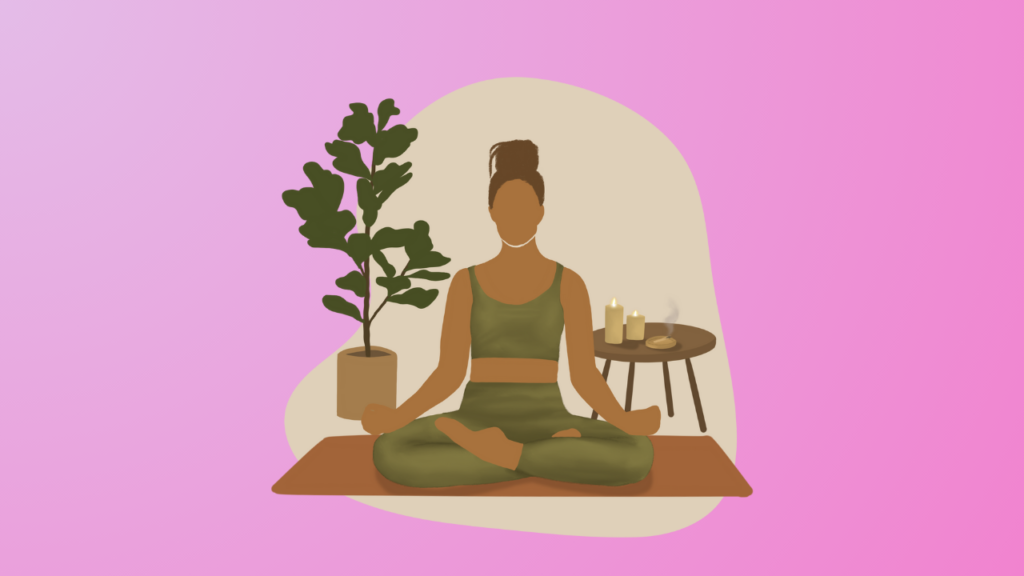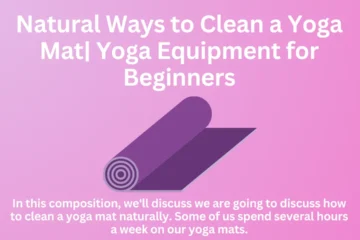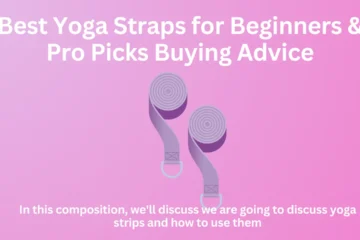For newcomers, welcome to my yoga blog, a comprehensive companion to the essential things to bring to your first yoga class as a yoga beginner. In this blog post, we will bandy the yoga equipment for beginners for anyone who joins the yoga journey to stay fit and calm, disconfirming common misconceptions and shedding light on what truly matters.
You’ve heard about all the wonderful advantages that yoga provides, so you’ve decided to enroll in your first session. Yoga can assist with back pain, lessen stress and anxiety, raise your quality of life, and even lower your blood pressure. Additionally, yoga helps increase strength, flexibility, and fitness. Having the appropriate items will make your first yoga lesson seem more comfortable, even if it can be somewhat intimidating for beginners.
We’ll be discussing eight important items to bring to your first yoga lesson as a consequence.
- Yoga Mat
- A Water Bottle
- A Little Towel
- Yoga Clothes
- Open Minded
Nice to Have, but Not Essential
- Yoga Block
- Yoga Strap
- After-Yoga Snack
- Towel for Yoga
1) Yoga Clothes
You should bring an additional change of clothes if you find it difficult to change out of your yoga attire after practice. If you have someone you’re meeting right after your session, this could be helpful. When meeting up with pals, you can wear jeans and a loose top; otherwise, if you have work later, you can wear business attire. Additionally, while showers are available at certain gyms, they may not always be available at all. Because of this, you should also bring deodorant or perfume to guarantee that you smell nice after your yoga practice.

Why Is Comfortable Yoga Clothing Necessary?
For the initial yoga lesson, you must have an active, comfortable year. Wearing suitable clothes may boost your self-esteem and inspire you to succeed in class. Wearing loose yoga pants, comfy tights, and an encouraging shirt are examples of clothing that will allow you to move and stretch freely. But it’s also crucial to wear clothing for yoga that won’t shift around much as you practice. This is important since you want to make the most of the lesson and you aren’t interested in worrying about a wardrobe malfunction.
2) After-Yoga Snack
Including a pot-yoga snack in your exercise bag is a smart idea. In this manner, you’ll have something to eat following an intense workout. Almonds, cereals, protein bars, smoothies, and even coconut water are excellent snacks. This is especially important if you have hypoglycemia. Make sure you’ve done your homework on the local eateries if you intend to have a drink or something to eat after your yoga class.
3) Yoga Mat
Although most yoga studios supply gym and yoga mats, it’s still an excellent choice to bring your own, well-cleaned, and ready-to-use mat. However, if you’re not sure whether you want to dedicate yourself to taking these yoga lessons, you can just show up a few minutes early to rent a yoga mat from the studio or take advantage of the gym’s offered mat, which you can clean yourself.
What Qualities Does a Good Yoga Mat Need to Have?
Bring your yoga mat to class if you have one. Having high traction is beneficial while performing postures like Warrior since it keeps your feet from slipping about, although it’s not strictly essential. In addition to providing a pleasant cushion between you and the floor, a decent mat will aid with your balance.
Investing in a mat is a fantastic idea if you don’t already have one. These are fantastic entry-level mats, and you can get them for as little as $20 to $30. If you anticipate doing yoga for many years, you might want to spend more money on a better mat. My personal favorites are the Mandaka Yoga Mats and the Jade Yoga Mats, which are also popular among yoga instructors.
We are not compensated to recommend any of these mats. These are the mats that, in my over ten years of practicing and instructing people in yoga, I have found to be of excellent quality, durable, and beneficial to your practice.
A yoga mat is designed to avoid slips and falls and to offer stability during practice. To perform poses comfortably and easily, yoga mats’ dense construction provides cushioning support for the joints. Invest in a good quality mat and make sure it is durable and cost-effective, while cheaper mats seem like a bargain. Buy a mat with an adequate grip without being excessively sticky, striking a balance between safety and allowing for natural movement.

4) Water Bottle
It’s a good idea for novices to carry their water bottle, even though most gyms give one. In this manner, people may stop depending on cassette water or standing in line to get a bottle of water at the gym.
Furthermore, make sure that your water container can hold a large amount of water because yoga can cause excessive perspiration and fatigue, particularly in your first class. Additionally, you may avoid buying a new bottle of fluid or rushing to the restroom to get more.
Why is Water Essential for Yoga Practice?
Yoga has similarities to a complete body massage. Toxins that have been accumulated are released when you exercise and stretch your muscles. For this reason, you should drink a lot of water both during and after your lesson, much like you would with a massage.
This will improve your energy levels and aid in the removal of pollutants from your body. Thus, remember to include a bottle of water in class so you can stay hydrated and remove toxins from your body.
5) Towel
Towels are essential for sweat-converting practices like hot yoga or vinyasa, From your face to the furnishing bumper under your knees, a handkerchief is ideal for wiping sweat. To prevent slips and maintain hygiene, a larger towel can be used to cover your mat. Regular towels can serve the purpose just as effectively, while specialized yoga towels are available.
Utilize a Towel to Prevent Slippage
- Not everybody requires this. Yes, I do. And perhaps you as well.
- To remove perspiration, you should bring a towel to your yoga class.
- This will facilitate your traction on your mat and ease the flow of your yoga courses.
- For the majority of individuals, a large hand towel suffices.
- You can carry on with your practice after wiping the perspiration from your face and body.
- You might want a full body-length towel to drape on top of your mat if you practice yoga after a strenuous workout, enjoy hot yoga courses, or wear a great sweater.
- This will provide you with a practicing surface that is absorbent and allow you to maintain optimal traction as you

6) Yoga Blocks
In achieving proper alignment and enhancing flexibility, yoga blocks are versatile props. Yoga blocks promote safety, prevent injury, and provide support in poses where reaching the floor may be challenging. Investing in a set of quality blocks is recommended; they can adapt to your practice as you progress in skills and strength.
How Do Yoga Blocks Help Your Practice?
Yoga blocks don’t have to be purchased right away. This is a useful but optional piece of equipment for yoga. A yoga block is a rectangular, hard foam, cork, or wooden block that is roughly the size of a football. When you are unable to bend down, you utilize them to assist in “bringing the ground closer to you.”
In this manner, you will have a surface to support your weight and ease into the yoga posture. If you are a frequent yoga practitioner but find it difficult to reach the floor in all of the recommended poses, using a yoga block will make your practice safer and more enjoyable.
Note: “Props” might refer to bolsters, blocks, straps, pillows, and even blankets. You may use them in the classroom to assist with alignment, or positioning your body correctly.
7) Yoga Straps
As a beginner, we used hand towels, not strips. Strips are used during Iyengar yoga to get you in a yoga pose. Buy a 6-foot-long strip that features a metal D, which is more comfortable.

When Will You Find a Use for a Yoga Strap?
When you can’t always reach your toes or the limb you’re supposed to hold, yoga straps come in quite handy. For instance, you are required to hold your hands behind your back when performing the Cow Face posture, Gomukhasana. Many are unable to accomplish this. They can hold the posture and even bring their fingers closer together, increasing the stretch and range of motion, since they have something to hang onto with both hands when they use a strap.
If you are unable to reach your toes, try Paschimottanasana, a seated forward bend. You may get the grip you need to ease into the stretch by putting a strap around your feet. Thus, you should always bring a towel, a glass of water, and your mat to yoga classes. Getting a few props, like a block and strap, might be a good idea if you plan to practice frequently.
8) An Open Mind
One thing you should bring to the initial yoga lesson is an open mind. If things don’t go as planned, you won’t be hasty to criticize the event or punish yourself. Instead, you’ll approach it with an open mind. You won’t worry about whether you’re strong or even enough flexible in this way. People also like yoga for its fitness benefits and for helping them become healthier and better versions of themselves. You need to choose the ideal gym to visit now that you are aware of everything you need to bring to your first yoga lesson.
Conclusion
In conclusion, the aware connection with oneself and the practice, but the substance of yoga, lies not in the abundance of equipment. Newcomers can lay a strong foundation for their yoga trip by fastening on essential outfits like yoga mats and blocks. The quality of the equipment enhances safety, comfort, and overall enjoyment, making the investment worthwhile in the long run. If you ever feel confused or need guidance, reach out to us through our contact form. I wish you a fulfilling and perfect yoga experience ahead!



0 Comments